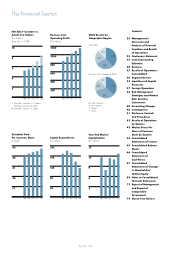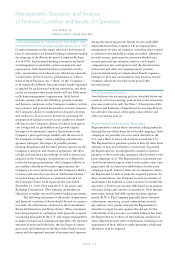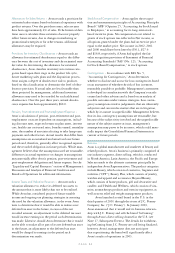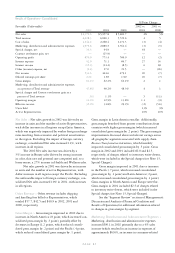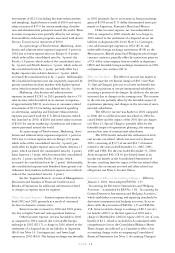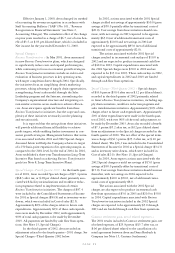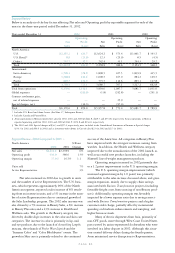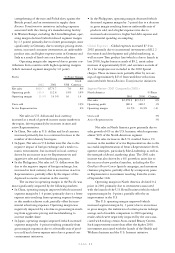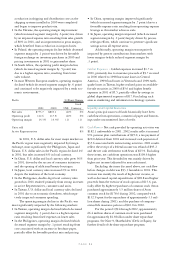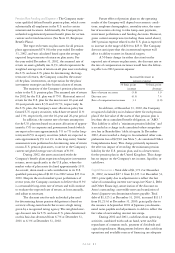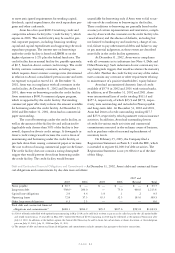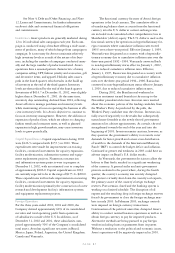Avon 2001 Annual Report Download - page 3
Download and view the complete annual report
Please find page 3 of the 2001 Avon annual report below. You can navigate through the pages in the report by either clicking on the pages listed below, or by using the keyword search tool below to find specific information within the annual report.
PAGE 26
Allowances for Sales Returns >Avon records a provision for
estimated sales returns based on historical experience with
product returns. Over the past three years, sales returns
have been approximately 4% of sales. If the historical data
Avon uses to calculate these estimates does not properly
reflect future returns, due to changes in marketing or
promotional strategies or for other reasons, additional
allowances may be required.
Provisions for Inventory Obsolescence > Avon records an
allowance for estimated obsolescence equal to the differ-
ence between the cost of inventory and the estimated mar-
ket value. In determining the allowance for estimated
obsolescence, Avon classifies inventory into various cate-
gories based upon their stage in the product life cycle,
future marketing sales plans and the disposition process.
Avon assigns a degree of obsolescence risk to products
based on this classification to determine the level of obso-
lescence provision. If actual sales are less favorable than
those projected by management, additional inventory
allowances may need to be recorded for such additional
obsolescence. Over the past three years, annual obsoles-
cence expense has been approximately $60.0.
Pension, Post-retirement and Post-employment Expense >
Avon’s calculations of pension, post-retirement and post-
employment costs are dependent on assumptions, includ-
ing discount rates, expected return on plan assets, interest
cost, health care cost trend rates, benefits earned, mortality
rates, the number of associates electing to take lump-sum
payments and other factors. Actual results that differ from
assumptions are accumulated and amortized over future
periods and, therefore, generally affect recognized expense
and the recorded obligation in future periods. While man-
agement believes that the assumptions used are reasonable,
differences in actual experience or changes in assumptions
may materially affect Avon’s pension, post-retirement and
post-employment obligations and future expense. See the
“Liquidity and Capital Resources” section of Management’s
Discussion and Analysis of Financial Condition and
Results of Operations for additional information.
Income Taxes and Valuation Reserves >Avon records a
valuation allowance to reduce its deferred tax assets to
the amount that is more likely than not to be realized.
While Avon has considered projected future taxable
income and ongoing tax planning strategies in assessing
the need for the valuation allowance, in the event Avon
were to determine that it would be able to realize a net
deferred tax asset in the future, in excess of the net
recorded amount, an adjustment to the deferred tax asset
would increase earnings in the period such determination
was made. Likewise, should Avon determine that it would
not be able to realize all or part of its net deferred tax asset
in the future, an adjustment to the deferred tax asset
would be charged to earnings in the period such
determination was made.
Stock-based Compensation >Avon applies the recogni-
tion and measurement principles of Accounting Principles
Board (“APB”) Opinion 25, “Accounting for Stock Issued
to Employees,” in accounting for its long-term stock-
based incentive plans. No compensation cost related to
grants of stock options was reflected in Net income, as
all options granted under the plans had an exercise price
equal to the market price. Net income in 2002, 2001
and 2000 would have been lower by $30.1, $27.6
and $16.8, respectively, if Avon had applied the fair
value recognition provisions of Statement of Financial
Accounting Standards (“FAS”) No. 123, “Accounting
for Stock-Based Compensation,” to stock options.
Contingencies >In accordance with FAS No. 5,
“Accounting for Contingencies,” Avon determines
whether to disclose and accrue for loss contingencies based
on an assessment of whether the risk of loss is remote,
reasonably possible or probable. Management’s assessment
is developed in consultation with the Company’s outside
counsel and other advisors and is based on an analysis of
possible outcomes under various strategies. Loss contin-
gency assumptions involve judgements that are inherently
subjective and can involve matters that are in litigation,
which by its nature is unpredictable. Management believes
that its loss contingency assumptions are reasonable, but
because of the subjectivity involved and the unpredictable
nature of the subject matter at issue, management’s
assumptions may prove to be incorrect, which could mate-
rially impact the Consolidated Financial Statements in
current or future periods.
Business
Avon is a global manufacturer and marketer of beauty and
related products. Avon’s business is primarily comprised of
one industry segment, direct selling, which is conducted
in North America, Latin America, the Pacific and Europe.
Sales are made to the ultimate customers principally by
independent Avon Representatives. The product categories
include Beauty, which consists of cosmetics, fragrance and
toiletries (“CFT”); Beauty Plus, which consists of jewelry,
watches and apparel and accessories; Beyond Beauty,
which consists of home products, gift and decorative and
candles; and Health and Wellness, which consists of vita-
mins, aromatherapy products and exercise equipment, as
well as stress relief and weight management products.
Avon launched a retail brand in the U.S. in the
third quarter of 2001 through the stores of J.C. Penney
Company, Inc. (“J.C. Penney”). In January 2003,
Avon announced that it would end its business relation-
ship with J.C. Penney and sell the brand “beComing”
through Avon’s direct selling channel in the U.S. (see
Note 17, Subsequent Events). The details for withdraw-
ing beComing from J.C. Penney are still being finalized;
however, Avon’s management does not anticipate
that repositioning the brand will significantly affect
Avon’s results of operations in 2003.

